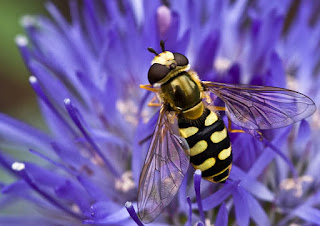 |
| Dunno mate, looks like a wasp to me (actually the hoverfly Eupeodes corollae). CC image by Bas Lammers |
You can make a wild stab in the dark (it's quick and doesn't require much effort - but you'll probably be wrong).
You can match its appearance to a picture in a book (this might work for something very distinctive, but pictures often don't show important diagnostic features, and most books don't usually have room to illustrate every species).
You can search the internet for something that looks like it, or ask in a forum (but you can't always be confident of the identification skills of random people).
You can ask an Expert (if you can find one, and they don't get fed up of doing your assignment for you).
Or you can use a key and gradually gain experience and expertise of your own in identifying the group it belongs to. This is more time consuming and requires some effort. But you'll be more likely to get to the correct answer.
Obviously I recommend the latter. Though there's a lot to be said for working with someone with more experience and picking their brain - they can highlight the most important features of your plant or creature. And it doesn't hurt to collaborate with someone who's collecting the same group as you either. You will get used the quirks of your key, but another pair of eyes and a second opinion can often help - and you'll help each other improve.
You'll see I've recommended some keys for each of the taxonomic groups. Various styles exist.
This one's a lateral key - use a strip of paper to mark the features of your own specimen, and compare it to the pattern made by the ones identified in the key:
 |
| With apologies to Sarah Whild. Our specimen (a custard cream) must be further down the list. |
Lateral keys have an advantage in that you don't have to know every detail about your specimen (say if it's missing its fruit or antennae), or you mistake one of the features - you've still got a chance of matching most features and deducing an answer.
Most keys you'll see are dichotomous - they branch at each step and if you go the wrong way at any stage, you've had it. That's their disadvantage (especially if they're poorly worded or ask you about features you can't see). But a good dichotomous key will give you a selection of clear distinguishing features at each stage. Don't be downhearted if you find it difficult - depending on your taxonomic group, there may be a lot of terminology to get to grips with. But once you've struggled through the key a few times with different specimens, you'll be more confident about what it's trying to help you discern.
Once I know the sort of things the key asks, I find it really useful to start by making a little sketch of my plant or creature annotated with features I notice, or simply make a list. I find it makes it easier when I run it through the key. I'll try to make some pages illustrating this.
I won't rabbit on as the best way to understand your key is to use it - but if you're feeling brave I will just point out below that they can use different numbering systems. Don't feel scared by all the terminology - not all keys are so frightening and in any case I hope you may learn to love all those technical and specific words.
Most keys are set out like the beetle one below - you start by choosing between the pair of statements marked 1. and the "-" below the 1. Then you're given the number of the next pair of statements to read (either 2 or 6 in this case).
 |
| from Lindroth's carabid beetle key |
An alternative is illustrated below. The pair of statements to compare are marked with the same number (1 and 1). You might also see 1a and 1b in some keys. Stace either gives the number of the next pair of statements to read (eg. 2), or sends you off to another key (eg. 2. Koenigia). A little more confusing perhaps.
 |
| from Stace's hallowed Flora |
But the most confusing in my eyes is the one below. You probably won't come across it because it's rather old-fashioned, but I've used it in my forays into identifying flies. The first statement is 1 (as usual) but you have to compare it with the number in brackets next to it (in this case, 4). So you end up having to look down (or even over) the page.
You'll notice that you're not given the number of the next statement to read. That's because you're expected to just move onto the next one. So if you agreed with statement 1, you move down to statement 2 (and its partner 3). Alternatively, if you agreed with statement 4, the next is 5 (and 6).
 |
| from Fonseca's key to families of flies |
Anyway, I'm sure you'll be fine. But if you do have problems, just come and ask.

No comments :
Post a Comment